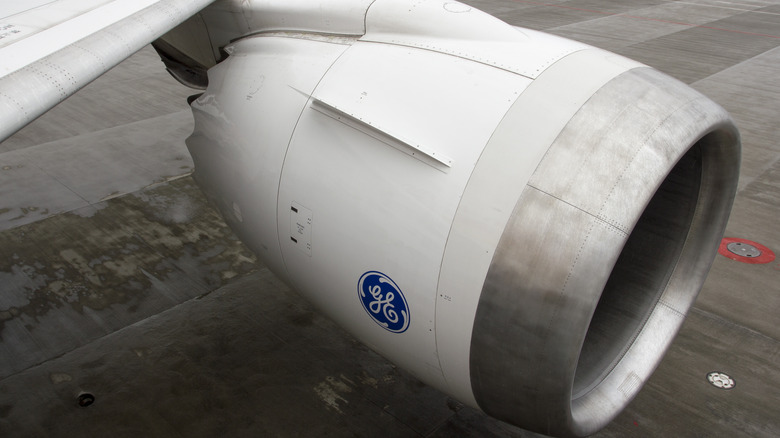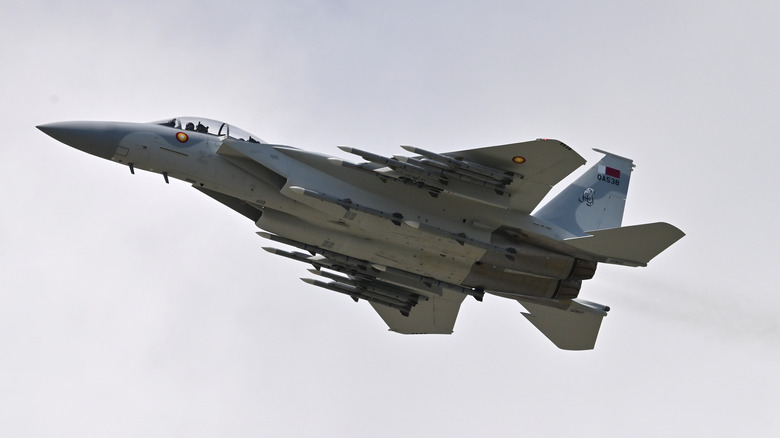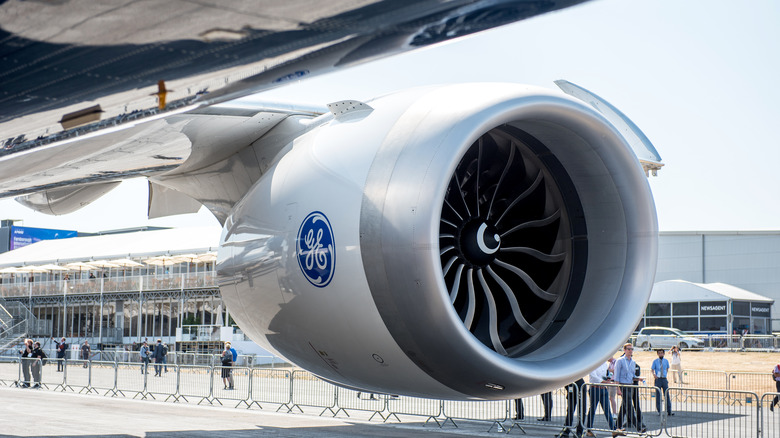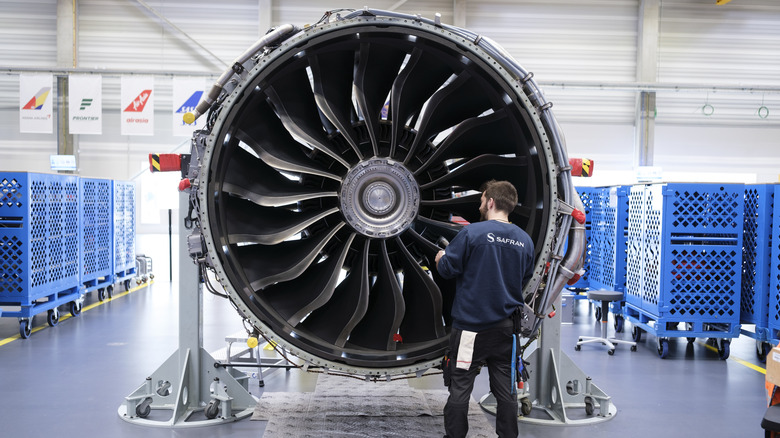Which Jet Engines Are Made By General Electric? Here's What You Need To Know
General Electric (GE) has been in operation for over 100 years and most consumers best know the brand for its many appliances, but that's not all it manufactures. From women-focused medical devices to gatling guns, there are many things you probably didn't know GE makes. Just as robust as its appliance catalog is the long list of jet engines GE manufactures for both commercial airlines and militaries around the globe. The company's history in aviation dates back to World War I when the U.S. needed the first aircraft engine "booster," otherwise known as a turbosupercharger. GE competed against another company and ultimately won the contract to create the turbosupercharger.
GE's reputation and credibility only improved throughout the war, earning it more defense contracts during the second World War. Well into WWII, the U.S. Army tasked GE with creating America's first jet engine. This was likely influenced from the Army seeing the incredible capabilities of the world's first combat jet fighter. GE rose to the challenge and not only built the nation's first jet engine, but went on to also make the first turbojet engines that would exceed twice and three times the speed of sound and then the first high bypass turbofan engine that would be put into operation.
GE has since been a go-to company for the U.S. Defense Department and other militaries around the world, but it didn't want to stop there. By 1971, GE Aerospace dove into the commercial airline market. Its success has earned the brand multiple accolades, including having engines that would power the president's Air Force One.
Combat jet engines
General Electric's Aerospace division has its engines in some of the most renowned fighter jets currently flying operations worldwide. The F-15EX Eagle II uses GE's F110-GE-129 engine that generates 29,000 pounds of thrust. With two of these engines, the F-15EX can get up to Mach 2.5, making it one of the world's fastest fighter jets. As a turbofan engine, it generates more thrust than a turbojet thanks to the 0.76 units of air that bypass the engine core. Various versions of Lockheed Martin's F-16 Falcon have been outfitted with either the F110-GE-100 or F110-GE-129 engine, depending on which country is using the F-16.
The U.S. Navy has relied on GE engines for over 30 years for its F/A-18E/F Super Hornet and EA-18G Growler. The F414turbofan engine family is based on the older F404 engine design, which powered the old F/A-18 Hornet. They use the F414-GE-400 turbo fan engine, which produces 22,000 pounds of thrust. It might not be as powerful as the Air Force's F-15EX, but NASA did order on F414-GE-100 engines for its X-59 quiet supersonic research aircraft. Beyond the United States, eight other nations utilize GE's F414 family of turbo fan engines for their militaries.
India has placed an order for over 100 of the F414 engines and are expecting to install them in the single-engine HAL Tejas Mark 2 by 2026. South Korea, on the other hand, has ordered over 120 for its twin-engine KF-21 Boramae multirole fighter jet. Sweden's been using F414 engines since 2021 in the Saab JAS 39E/F.
Commercial plane engines
General Electric has its engines on some of the biggest names in the commercial airline industry. Boeing put GE's GEnx engine on the 747-8 that the USAF chose to replace the current Air Force One. The GEnx engine has four variants that each produce varying degrees of power, starting at 66,500 pounds of thrust while the most powerful version generating 76,100 pounds of thrust. GE builds the GEnx engines with carbon fiber fan blades — that it started using on the GE90 engine — and titanium aluminide blades in the core that helps create a more powerful yet lighter engine.
Boeing's 777 airframes have been using the GE90 engine since the '90s, but some airlines are upgrading their 777X fleets to the GE9X engine that General Electric boasts as "The largest and most powerful commercial aircraft engine ever built." However, the fan on the GE9X is 134-inches in diameter, which is the same size as one of the two GE90 variants. The GE90-115B's diameter is 135-inches. The GE9X isn't even the longest engine as it's 220 inches while the GE90 is 287 inches. So the GE9X might not be the largest commercial jet engine, or even larger than the GE90, but it is likely as efficient as GE claims since it consumes 10% less fuel than the GE90-115B.
General Electric partners with other companies
General Electric is no stranger to working alongside other aerospace companies to achieve mutually beneficial goals. The aerospace firm and Honda — yes, that Honda — have created a small joint venture called GE Honda Aero Engines. This new company has been working on the HF120 turbofan engine, an engine for smaller private jets in the 2,000-pound thrust class, since 2008, delivering its first order in 2014.
GE also joined up with Safran Aircraft Engines in 1974 to create CFM International. Since its inception, CFM has delivered 39,000 engines, starting with the CFM56-2 on a McDonnell Douglas DC-8 in 1982. Over two decades later the company started manufacturing its LEAP engines, first installing a LEAP-1A onto an Airbus A320neo operated by Pegasus Airlines. Boeing uses the LEAP-1B engine on its 737 MAX line of airplanes while Comac's C919 uses the LEAP-1C engine.
As of 2023, CFM International had 10,000 LEAP engines on order and delivered over 5,000. However, CFM also has its CFM56-5B engine powering roughly 60% of the Airbus A320ceo planes in operation. CFM has also acquired military contracts that got its CFM56-7B engine under the wings of several non-combat military aircraft. The U.S. Navy uses Boeing's P-8 Poseidon for maritime patrols as well as search and rescue operations. The USAF ordered two of Boeing's E-7A Airborne Early Warning and Control aircraft that it will use to detect threats before they become a threat. The two aerospace firms have agreed to extending CFM's existence well into the 2050s.



